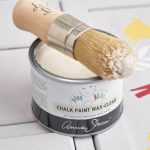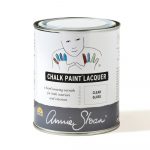Annie Sloan Chalk Paint Facts
As a rough guide, one litre of Chalk Paint™ covers approximately 13 square metres, or the equivalent of a small welsh dresser or china hutch.
For most purposes, one to two coats of paint are enough. Chalk Paint™ adheres to almost any surface, and there is rarely any need to sand or prime before painting. See ‘Dealing with stains coming through Chalk Paint™’ for when to prime or sand before painting.
To get started, tip the paint pot upside down and shake before use. Then open and stir well. If paint is too thick just add a little water and stir. For the best results, we recommend using a good quality paintbrush like the Chalk Paint™ Brushes to apply the paint.
Always finish Chalk Paint™ with either Chalk Paint™ Wax or Lacquer for protection.
You can paint Chalk Paint™ straight over Chalk Paint™ Wax without removing the prior finish – just ensure that it has fully cured before doing so.
USING CHALK PAINT™ WAX
Chalk Paint™ Wax is the perfect complement for Chalk Paint™. It adds durability, deepens the colours slightly and adds a very light sheen. It’s really easy to get sensational results – just use a Chalk Paint™ Wax Brush or lint-free cloth to apply the wax to paint. Remove any excess sitting wax with a lint-free cloth.
Finishing Chalk Paint™ with either wax or lacquer is essential; it will seal your finish for years to come and protect from scuffs and water marks.
As a very rough guide, you will need one 500ml tin of wax for every 3-4 litres of paint. This will vary depending on how many coats of paint or wax you use to cover a piece. And it’s always best to have a little wax left over for touching up. With the lid tightly on, it will last indefinitely.
For more information on Chalk Paint™ Wax, watch Annie’s instructional video by clicking here.
LETTING CHALK PAINT™ WAX CURE
After you’ve applied Chalk Paint™ Wax, you’ll find that it will become dry to the touch very quickly. At this stage, it is still what you might call ‘soft’. It will start to harden as the solvents in the wax evaporate. This hardening process is known as ‘curing’. Curing can take between 5 and 21 days depending on ambient temperature.
You can use your finished piece straight away, but you may need to treat it with extra care until the wax has cured completely (you might want to use coasters, avoid sharp objects etc). Once cured, a piece of furniture painted with Chalk Paint™ and finished with wax will stand up to normal wear and tear.
Chalk Paint™ Wax is food-safe and toy-safe when completely cured. For more information see Annie Sloan’s Product Information page.
HOW TO CARE FOR A CHALK PAINT™ AND WAX FINISH
Generally, wiping lightly with a damp/dry microfibre cloth should be sufficient to clean.
Stubborn marks on waxed pieces can often be removed with a little Clear Chalk Paint™ Wax on a cloth, which acts as an eraser. If you choose to use cleaner you will eventually wear away the wax, but if you would prefer to use a mild surface cleaner apply using a cloth and test in an inconspicuous area first. Regular use of cleaning products may require re-waxing over time.
Always use heat mats and coasters to protect your painted and waxed surfaces. Keep away from extreme temperatures or humidity. Like you, your finish prefers a moderate climate!
Waxes dissolve in alcohol, so using it on bars is not advisable.
Avoid aerosol spray polishes as they may contain solvents or silicone that could dissolve the wax
As a guide, one 750ml tin of Chalk Paint™ Lacquer will cover 19 square metres (204ft ²), but this will vary according to the absorbency of the material you’re painting. For best results the lacquer should be applied in very thin coats. Results may also vary depending on previous treatment of the surface.
When applying Chalk Paint™ Lacquer, bear in mind that it is a ‘penetrating’ finish and can pull tannins or stains from the wood up through the paint. This can be especially noticeable on whites, manifesting as a yellow stain. Always test Chalk Paint™ and Lacquer on several areas before you begin your project. If a stain appears, apply a stain blocker directly over the entire surface before painting and lacquering again.
For more information on Chalk Paint™ Lacquer, watch Annie’s instructional video by clicking here.
CAN YOU PAINT OVER STAINED WOOD WITH CHALK PAINT™?
The porous nature of Chalk Paint™ means that when the paint is applied to a surface which has been oiled or stained, it draws the stain up through the surface and into the paint, causing discolouration. To prevent this you need to create a seal between the oiled/stained/varnished furniture and your paint. You’ll want to use a water-based shellac such as Chalk Paint™ Lacquer to seal in the stain.
If you’re painting vintage furniture, check if it’s from the 1930s or ‘40s. Furniture from that period often has an oil-based finish that will create a stain. The same can happen if you’re working with new, untreated pine. As Chalk Paint™ adheres to the surface, it will draw out any oil stains or tannins in wood, even if they aren’t visible to the eye.
If you see a stain bleeding through the paint, apply a coat of stain blocker (or knotting solution) directly over the paint you have already applied. Treat the whole affected surface to avoid any patchiness in the final finish. One or two coats of blocker applied evenly with a cloth pad will block the stain. It dries in minutes, and then you can get on with your painting.
These stains can often be pulled through if Chalk Paint™ Lacquer is applied on to Chalk Paint™. If this is the case, do the same steps as above but over the Chalk Paint™ Lacquer you’ve already applied.
Chalk Paint™ is not recommended for teak or other oily woods. Always test, if in doubt! For more information on bleed through on floors, watch Annie’s instructional video by clicking here.
TOUCHING UP OR REPAIRING DAMAGE
As with any decorating paint, it’s not advisable to paint over small areas that need a touch up – even if you are working with paint from the same batch. When you apply a first coat of paint to a surface, the rate at which the water is absorbed by the surface (‘wicking’) has an effect on the final colour. Subsequent coats will be absorbed by the paint underneath at a different rate, leading to a subtle shade difference in the finish.
For this reason, where repairs are necessary, it’s advised to paint the entire surface of the affected area, whether this is a section of wall (from corner to corner & top to bottom) or the face of a piece of furniture (for example, a drawer front). There is no need to repaint the entire room or the whole piece of furniture! However, to save time, it’s worth testing by touching up just the small area first. If it looks fine, you can seal and leave. If not, apply as above.




